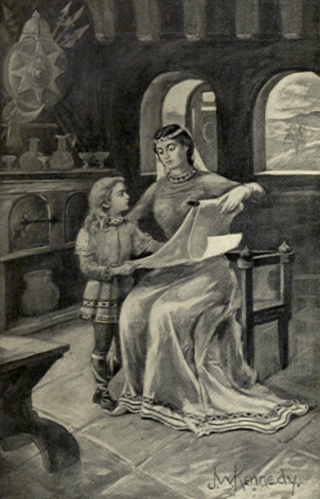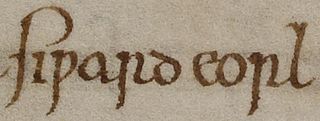Related Research Articles
Ælfheah, more commonly known today as Alphege, was an Anglo-Saxon Bishop of Winchester, later Archbishop of Canterbury. He became an anchorite before being elected abbot of Bath Abbey. His reputation for piety and sanctity led to his promotion to the episcopate and, eventually, to his becoming archbishop. Ælfheah furthered the cult of Dunstan and also encouraged learning. He was captured by Viking raiders in 1011 during the siege of Canterbury and killed by them the following year after refusing to allow himself to be ransomed. Ælfheah was canonised as a saint in 1078. Thomas Becket, a later Archbishop of Canterbury, prayed to Ælfheah just before his murder in Canterbury Cathedral in 1170.

Mercia was one of the three main Anglic kingdoms founded after Sub-Roman Britain was settled by Anglo-Saxons in an era called the Heptarchy. It was centred on the River Trent and its tributaries, in a region now known as the Midlands of England.
Godwin of Wessex was an Anglo-Saxon nobleman who became one of the most powerful earls in England under the Danish king Cnut the Great and his successors. Cnut made Godwin the first Earl of Wessex. Godwin was the father of King Harold II and of Edith of Wessex, who in 1045 married King Edward the Confessor.

Edward the Confessor was an Anglo-Saxon English king and saint. Usually considered the last king of the House of Wessex, he ruled from 1042 until his death in 1066.
Leofric was a medieval Bishop of Exeter. Probably a native of Cornwall, he was educated on the continent. At the time Edward the Confessor was in exile before his succession to the English throne, Leofric joined his service and returned to England with him. After he became king, Edward rewarded Leofric with lands. Although a 12th-century source claims Leofric held the office of chancellor, modern historians agree he never did so.

Coenwulf was the king of Mercia from December 796 until his death in 821. He was a descendant of King Pybba, who ruled Mercia in the early 7th century. He succeeded Ecgfrith, the son of Offa; Ecgfrith only reigned for five months, and Coenwulf ascended the throne in the same year that Offa died. In the early years of Coenwulf's reign he had to deal with a revolt in Kent, which had been under Offa's control. Eadberht Præn returned from exile in Francia to claim the Kentish throne, and Coenwulf was forced to wait for papal support before he could intervene. When Pope Leo III agreed to anathematise Eadberht, Coenwulf invaded and retook the kingdom; Eadberht was taken prisoner, was blinded, and had his hands cut off. Coenwulf also appears to have lost control of the kingdom of East Anglia during the early part of his reign, as an independent coinage appears under King Eadwald. Coenwulf's coinage reappears in 805, indicating that the kingdom was again under Mercian control. Several campaigns of Coenwulf's against the Welsh are recorded, but only one conflict with Northumbria, in 801, though it is likely that Coenwulf continued to support the opponents of the Northumbrian king Eardwulf.

Werburgh was an Anglo-Saxon princess who became the patron saint of the city of Chester in Cheshire. Her feast day is 3 February.

Osburh or Osburga was the first wife of King Æthelwulf of Wessex and mother of King Alfred the Great. Alfred's biographer, Asser, described her as "a most religious woman, noble in character and noble by birth".

Leofric was an Earl of Mercia. He founded monasteries at Coventry and Much Wenlock and was a very powerful earl under King Cnut and his successors. Leofric was the husband of Lady Godiva.
Leofwine was appointed Ealdorman of the Hwicce by King Æthelred the Unready of England in 994. The territory of the Hwicce was a kingdom in the Western Midlands in the early Anglo-Saxon period, which soon became a subdivision of Mercia. Leofwine was the son of Ælfwine, who is otherwise unknown, but the family appears to have originated in the East Midlands. Leofwine and his sons were considered by the See of Worcester as spoliators who seized church land, but East Midlands religious establishments regarded them as benefactors.

Siward or Sigurd was an important earl of 11th-century northern England. The Old Norse nickname Digri and its Latin translation Grossus are given to him by near-contemporary texts. It is possible Siward may have been of Scandinavian or Anglo-Scandinavian origin, perhaps a relative of Earl Ulf, although this is speculative. He emerged as a regional strongman in England during the reign of Cnut. Cnut was a Scandinavian ruler who conquered most of England in the 1010s, and Siward was one of many Scandinavians who came to England in the aftermath, rising to become sub-ruler of most of northern England. From 1033 at the latest, he was in control of southern Northumbria, present-day Yorkshire, governing as earl on Cnut's behalf.

Eadnoth the Younger or Eadnoth I was a medieval monk and prelate, successively Abbot of Ramsey and Bishop of Dorchester. From a prominent family of priests in the Fens, he was related to Oswald, Bishop of Worcester, Archbishop of York and founder of Ramsey Abbey. Following in the footsteps of his illustrious kinsman, he initially became a monk at Worcester. He is found at Ramsey supervising construction works in the 980s, and around 992 actually became Abbot of Ramsey. As abbot, he founded two daughter houses in what is now Cambridgeshire, namely, a monastery at St Ives and a nunnery at Chatteris. At some point between 1007 and 1009, he became Bishop of Dorchester, a see that encompassed much of the eastern Danelaw. He died at the Battle of Assandun in 1016, fighting Cnut the Great.
Northman was a Mercian noble of the early 11th century. A member of a powerful Mercian kinship (clan), he is known primarily for receiving the village of Twywell in Northamptonshire from King Æthelred II in 1013, and for his death by order of King Cnut the Great (Canute) in 1017. His violent end by Cnut contrasts with the successful career enjoyed by his brother Leofric, as Earl of Mercia during Cnut's reign. Northman is believed to have been an associate of the troublesome ealdorman Eadric Streona, who was killed with him.
Indract or Indracht was an Irish saint who, along with his companions, was venerated at Glastonbury Abbey, a monastery in the county of Somerset in south-western England. In the High Middle Ages Glastonbury tradition held that he had been an Irish pilgrim — a king's son – on his way back from Rome who was molested and killed by a local thegn after he had stopped off to visit the shrine of St Patrick. This tradition synchronised his life with that of King Ine (688–726), though historian Michael Lapidge has argued that he is most likely to represent a 9th-century abbot of Iona named Indrechtach ua Fínnachta.
Repton Abbey was an Anglo-Saxon Benedictine abbey in Derbyshire, England. Founded in the 7th century, the abbey was a double monastery, a community of both monks and nuns. The abbey is noted for its connections to various saints and Mercian royalty; two of the thirty-seven Mercian Kings were buried within the abbey's crypt. The abbey was abandoned in 873, when Repton was overrun by the invading Great Heathen Army.

Various monasteries and other religious houses have existed at various times during the Middle Ages in the city of Exeter, Devon, England.

Monks Kirby Priory was a Benedictine priory established in 1077 in Monks Kirby, Warwickshire, England. The priory was suppressed in 1415 when its estates and revenues were given to the Carthusian priory of Axholme in Lincolnshire, in whose possession they continued until the Reformation. Remains of the priory form part of Monks Kirby village church today.

St Mary's Priory and Cathedral was a Roman Catholic institution in Coventry, England, founded in the 12th century by transformation of the former monastery of St Mary, and destroyed during the Dissolution of the Monasteries in the early 16th century. It was located on a site north of Holy Trinity and the former St Michael's parish churches in the centre of the city, on a site bordered by Priory Row to the south, Trinity Street to the west, and the River Sherbourne to the north. Excavated remains from the west end of the cathedral are open to the public.
Ceatta of Lichfield is an obscure Anglo Saxon saint of the Catholic Church.
References
- Baxter, Stephen (2007), The Earls of Mercia: Lordship and Power in Late Anglo-Saxon England, Oxford: Oxford University Press, ISBN 978-0-19-923098-3
- Blair, John (2002), "A Handlist of Anglo-Saxon Saints", in Thacker, Alan; Sharpe, Richard (eds.), Local Saints and Local Churches in the Early Medieval West, Oxford: Oxford University Press, pp. 495–565, ISBN 0-19-820394-2